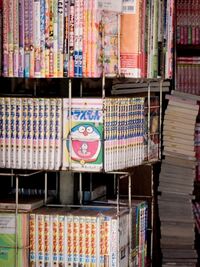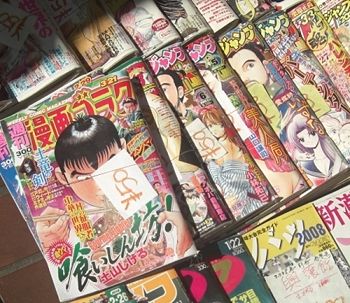Manga
Please note that some of us are intending to restart this article from scratch (see Talk). The introduction may be incorporated into material here.
One of the most popular forms of entertainment in Japan is manga (漫画), meaning 'comic' or 'cartoon'; in recent years, Japanese-style comics have also become more popular overseas, and the word is now firmly established in the English language to refer to these.
From a Western perspective, manga appear similar to the more adult-orientated graphic novel, but in Japan they are a staple of popular culture and are read by people of all ages. They also serve as an interesting way of getting the news: government ministries as well as corporations have often used manga to put across complicated ideas to the public.[1]
Typically, manga are printed in black and white, and as is the case with much other Japanese reading matter, they are read from right to left, top to bottom, starting from the 'back' of the book.
In Japan, manga fans can be seen reading their favourite stories in 24-hour convenience stores or with coffee in special round-the-clock 'manga cafés' (漫画喫茶 or マンガ喫茶, manga kissa). Another place to find the legions of manga readers is at the three-day 'Comic Market' (コミック・マーケット Komikku Māketto) in Tokyo, Japan's largest public indoor gathering; at this magazine fair a vast number of manga are available to browse and buy.[2]
Famous manga

Manga on sale featuring one of the best-known Japanese cartoon characters, the time-travelling robot cat 'Doraemon'.
Manga stories cover all kinds of adventures, with four creations particularly well-known; of course, there are thousands of other characters and storylines being produced in Japan and worldwide every year.
Material moved to stubs
Astro Boy
The artist Osamu Tezuka (手塚 治虫 Tezuka Osamu) became known as the 'God of Manga' for giving the world his robot-child Astro Boy (or Mighty Atom, i.e. 鉄腕アトム Tetsuwan Atomu) in 1952.[3]
Black Jack
Osamu Tezuka was also responsible for developing Black Jack (ブラック・ジャック) in the 1970s; this is the tale of a facially-scarred underworld surgeon who performs implausibly brilliant operations to save the innocent.
Sazae-san
Machiko Hasegawa (長谷川町子 Hasegawa Machiko) created the independently-minded lady Sazae-san (サザエさん), and was also one of the first female manga artists.
Doraemon
The time-travelling mechanical cat Doraemon (ドラえもん) has been thrilling readers since 1969. These adventures have been the recipient of several awards, including Asahi Shimbun's 'Tezuka Osamu Cultural Prize' (手塚治虫文化賞, Tezuka Osamu Bunkashō) in 1997. The cat was also recognised by Time Asia magazine in 2006 as an 'Asian Hero', or cultural icon.[4]
Footnotes
- ↑ Kinsella (2000). For a controversial example of the use of manga to explain defence policy, see Mainichi Daily News: 'Defense Ministry turns to 'Lolita' manga character to reveal inner self'. 24th July 2007.
- ↑ Comiket.co.jp: 'What is the Comic Market?'. Official information from the organising committee.
- ↑ Schodt (2007).
- ↑ Time Asia: 'The Cuddliest Hero in Asia'. 2006.
